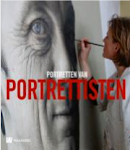 |
| El Economista, image El Jefe by M.Polin |
This article talks about the influence of the Mexican Drugs War in the arts, days after the "official" release of the ex-presidential candidate and lawyer Diego Fernandez de Cevallos. He was kidnapped for 7 months. This information is in part what the title of the article by Vicente Gutierrez from El Economista is refering to. The image of the article is my painting El Jefe based on the photo made of Fernandez de Cevallos by his kidnappers.
 | ||||||||
The narco kidnaps the fine arts
Vicente Gutiérrez / El Economista, Mexico / 22 December 2010
Film, theater, art installations, music, novels, art and television series are inspired by drug trafficking and violence in Mexico to create works of art. But the narco goes beyond the social phenomenon that causes the lifestyles of drug dealers, that many that many young people copy in their dream to be rich like them. Increasingly, the artists take the drugs world as a theme to create.
"It is impossible to ignore the horror that exists in many cities, borders and roads of the country and this affects all activities or people," said the writer Martin Solares.
"In Mexico's artists have begun to reflect on their creations the increasing daily violence or the presence of drug traffickers. Even in the Mexican poems and novels occasionally appears a testament to the violence! "He said. After the federal government declared war on drug trafficking, the issue has been more present than ever in the Fine Arts and has become the "tough" face of Mexico in the world. Just remember that for the 53 Venice Biennale, the artist Teresa Margolles showed an installation of a room soaked with blood and debris of various murders and had jewelry made with scrap from the drugs war.
The art curator Cuauhtémoc Medina explained that "jewelry made from fragments of windshield glass, embroidered in gold on blood and sound recordings of the landscapes of death aphorisms murderers, they all converge to produce a space for reflection, physical threat and anxiety."
Or what the artist Marisa Polin did in The Netherlands, who intervened a picture of Diego Fernandez de Cevallos blindfolded. Although this was the most innocent part of the exhibition where executions, beheaded, tortured and kidnapped were shown in her drawings and paintings that raised a lot of noise.
What about El Infierno / The Hell, Luis Estrada film which grossed 83 million 82 thousand 542 pesos to register as the second highest grossing film in Mexican cinema in 2010 which tells the story of an ordinary man who ends up as a drug trafficker.
etcetera...
"It is impossible to ignore the horror that exists in many cities, borders and roads of the country and this affects all activities or people," said the writer Martin Solares.
"In Mexico's artists have begun to reflect on their creations the increasing daily violence or the presence of drug traffickers. Even in the Mexican poems and novels occasionally appears a testament to the violence! "He said. After the federal government declared war on drug trafficking, the issue has been more present than ever in the Fine Arts and has become the "tough" face of Mexico in the world. Just remember that for the 53 Venice Biennale, the artist Teresa Margolles showed an installation of a room soaked with blood and debris of various murders and had jewelry made with scrap from the drugs war.
The art curator Cuauhtémoc Medina explained that "jewelry made from fragments of windshield glass, embroidered in gold on blood and sound recordings of the landscapes of death aphorisms murderers, they all converge to produce a space for reflection, physical threat and anxiety."
Or what the artist Marisa Polin did in The Netherlands, who intervened a picture of Diego Fernandez de Cevallos blindfolded. Although this was the most innocent part of the exhibition where executions, beheaded, tortured and kidnapped were shown in her drawings and paintings that raised a lot of noise.
What about El Infierno / The Hell, Luis Estrada film which grossed 83 million 82 thousand 542 pesos to register as the second highest grossing film in Mexican cinema in 2010 which tells the story of an ordinary man who ends up as a drug trafficker.
etcetera...
Excerpto en Español de: La narcocultura secuestra las bellas artes
Vicente Gutiérrez / El Economista, Mexico / 22 December 2010
Vicente Gutiérrez / El Economista, Mexico / 22 December 2010
Cine, obras de teatro, instalaciones de arte, música, novelas, artes plásticas y series de televisión se inspiran en el narcotráfico y la violencia en México para crear obras artísticas.
Pero la narcocultura va más allá del fenómeno social que provoca el estilo de vida de los narcotraficantes, ése que muchos jóvenes copian en su sueño por ser ricos como ellos.
Cada vez más, los artistas toman el narco como materia para crear.
“Es imposible ignorar el horror que se vive en tantas ciudades, fronteras o carreteras del país y esto afecta a todas las actividades o personas”, explicó el escritor Martín Solares.
“En México los artistas más exquisitos y solipsistas han comenzado a reflejar en sus creaciones el aumento de la violencia cotidiana o la presencia de los narcotraficantes. ¡Hasta en los poemas y en las novelas de ciencia ficción mexicanas aparece de vez en cuando un testimonio de la violencia!”, agregó. Después de que el gobierno federal declaró la guerra al narcotráfico, el tema ha estado más presente que nunca en las Bellas Artes y se ha convertido en el rostro “duro” de México en el mundo. Basta recordar que para la 53 Bienal de Venecia, la artista Teresa Margolles presentó instalaciones sobre el narco con una habitación empapada con sangre, residuos de distintos asesinatos y joyas hechas con desechos de la guerra del narcotráfico.
El curador de arte Cuauhtémoc Medina explicó que “joyas hechas con fragmentos de parabrisas, aforismos asesinos bordados en oro sobre sangre, sonidos grabados en los paisajes de la muerte, todos ellos convergen para producir un espacio de reflexión, amenaza corporal y ansiedad”.
O lo que hizo en Holanda la artista plástica Marisa Polin quien intervino una foto de Diego Fernández de Cevallos con los ojos vendados, aunque es la pieza más inocente de la exposición ante los ejecutados, decapitados, torturados y secuestrados que aparecen en sus dibujos y pinturas que levantaron mucho ruido.
Qué decir de El Infierno, película de Luis Estrada que recaudó 83 millones 82 mil 542 pesos para colocarse como la segunda cinta más taquillera del cine mexicano en el 2010 donde relata la historia de un hombre común que acaba como narcotraficante.




















No comments:
Post a Comment